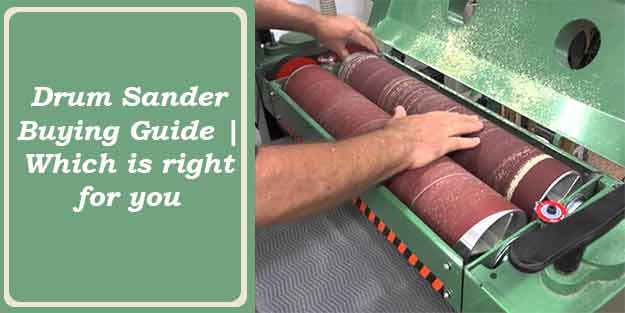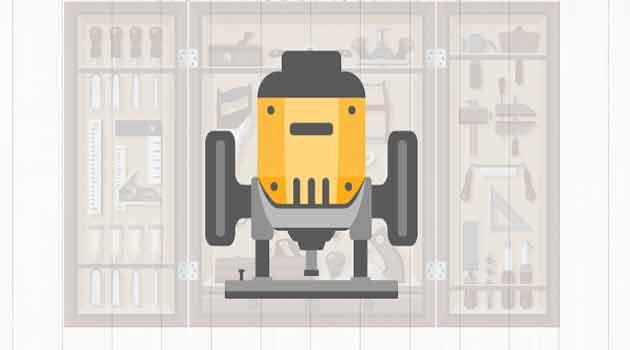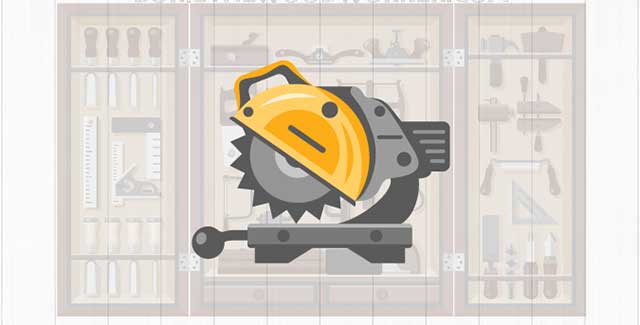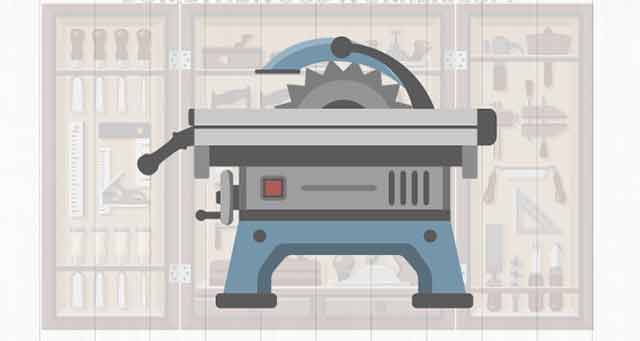In woodworking, a drum sander is a machine that is used in sanding wood to achieve a plain and consistent surface. There are other sanding alternatives that you can consider, but these are usually marred in inefficiencies of some sort. It is these inefficiencies that you eventually overcome when you use the best drum sander.
Drum sanders operate at different speeds, which will help you achieve the result you desire faster than you would if you were sanding with other power tools or sanding with your hand.
Table of Contents
How to Get Utmost Utility from Your Drum Sander
You might have just purchased a good drum sander, but are you really sure you can fully maximize its potential? The following are a few ideas that will help you get the best results whenever you are using the drum sander:
Should I Buy Or Rent?
It is no secret that drum sanders do not come cheap. Therefore, if you are planning to use it for so many years, perhaps because you continually have sanding projects, then it would be safer to buy one. In case you are only going to use it once, it would be wiser to rent a drum sander.
Get the Right Sandpaper Grits
Sandpaper grit simply means how rough the sandpaper is. For efficiency and a good chance of getting impressive results, you need to buy a variety of sandpaper grits, or you might end up overusing the one you have, and not achieve good results.
Learn How to Fix Sandpaper
You might be surprised, but a lot of people actually do not know how to fix sandpaper onto the drum sander. You can ask the staff from where you are getting the sander to show you how to do it, and even try it under their supervision to make sure you do it right.
Stay Away From Extension Cords
There is a good chance that the sander might draw too much power than your extension cord can handle. For this reason, using the extension cord could easily see it get damaged. Alternatively, if you have to buy an extension cord, make sure that it is using the same type of wire that was used in the sander’s cord.
What Are the Criteria to buy Drum Sander?
When you set out to buy a drum sander, you are making a sizeable investment into this appliance. It is important, therefore, that you take your time and learn how to get the best sander. The following are some ideas that you should consider that will help you choose the best sander:
Dust Collection
While in use, a lot of sawdust is produced. It is therefore imperative that you should choose a drum sander that has a sizeable dust collection point. This is not just about keeping your working area clean, but staying away from sawdust is also good for your health.
Superior Performance
The sander you are spending your money on should be able to meet your needs. This is usually determined by the type of plane you intend on passing through the sander. In case you work with a lot of hardwood, you need a sander that can withstand the strength of hardwood, so go for power over anything else.
Consider Reviews
For someone who is about to make their first drum sander purchase, it is wise for you to learn from the experience of other people before you, who have used the machine you are about to buy. Read some reviews from the manufacturer website, read reviews from websites like Amazon and learn more about the different types of sanders.
Reviews will help you learn about certain flaws in the design of the drum sander, and how these flaws might affect your working style. Through reviews, you might also learn some new information about the drum sanders that might never have occurred to you earlier.
Speed Control
You need to find a drum sander that offers you unprecedented control over the sanding speed. For this reason, choose one with variable speed control. This makes it easier for you to customize the output depending on your immediate needs.
Brand
There are different brands in the market. You should not make this your priority consideration because if you do you will end up spending on an expensive model that might be more powerful than you will ever need to use it for. However, it is wise to choose a brand that is recognized, one that has a long history of amazing performance.
Versatility
Most of the drum sanders you will come across on the market have a horizontal infeed. There are some that are versatile, and also have a vertical feed. Your choice should depend on the type of plane you are planning to work with.
Budget
For a fact, the best drum sanders are not exactly some of the cheapest equipment you will find in the market. Most sanders cost more than $2,000. Therefore, before you settle on a particular model, make sure that you consider your budgetary capacity.
Having considered how much you are willing to spend, you can then go ahead and compare different models based on their technical specifications and whether they will fit in your budget or not.
Portability
Whether you will need a portable or a stationary drum sander depends on the kind of work you do. In case most of the work is done in your workshop, there is nothing wrong with getting the bulky drum sanders. On the other hand, if you tend to move a lot, a portable sander would do your work some justice.
Do’s And Don’ts of a Drum Sander
Woodwork tools and any other tool you come across, for that matter, are only as effective as the way you use them. Some of these tools come with special instructions from the manufacturer that you are supposed to follow to the latter, especially if you want to get the best performance from the sander, and to make it serve you for so many years.
Using the right tool for the right purpose and in the correct manner will go a long way in helping you get great results. Here are some Dos and Don’ts of using a drum sander:
Do’s
Read The Manual
You will be surprised at the number of people who barely take the time to go through manuals. Like most machines and tools, make sure you read the manufacturer instructions so that you know how the drum sander works.
Changing The Sandpaper
Remember to pay attention to the sandpaper. It should be changed when it has exceeded its longevity. If you keep using sandpaper whose teeth have been ground, the drum sander will have to work harder to deliver good results, which negatively affects its performance.
Staying Safe
When the sander is not in use, make sure it is plugged off from the electricity supply. Most people just switch off the sander and leave it plugged into the power outlet. This is not a good idea because leaving it plugged in could increase the potential for significant danger and damage.
Repair And Maintenance
One of the easiest ways to prolong the life of your drum sander is proper repair and maintenance. Even if you have one of the best sanders in the market, dust still gets into the bearings, and if this is not removed as soon as possible, the drum sander could develop problems sooner than you know.
Rest Time
Irrespective of whether you have the best drum sander in the market or not, make sure you do not leave it running all through the day. When it is not in use, shut it down and unplug it from the power outlet. For electrical and mechanical appliances, you have to exercise caution, whether the manufacturer advertises the sander with a capacity to run the whole day or not.
Don’ts
Vertical Sanding
Not all the sanders are designed for vertical sanding. In fact, you MUST only use the sander for horizontal sanding to deliver a precise finish. There are, however, some brands that are versatile and offer both vertical feed and horizontal feed for sanding.
Using Force
Drum sanders are built for stable performance. They can handle their own weight and the weight of the plane you are sanding. Therefore, let their build handle the work. Do not induce more force to get better results, as this will only damage the sander.
Common Sanding Mistakes
While sanding is not really one of the most difficult tasks that you will have to do, it is also very easy to make simple mistakes. The mistakes might seem negligible when you come to think about it, but the effect on your results is immense.
Most of the mistakes people make when using the best drum sanders are either out of carelessness or ignorance. There are also a few instances of a procedural mix-up where you choose the wrong tool for the wrong job. The following are some of the mistakes that are so common when using a drum sander, especially for beginners:
Failure To Remove Sanding Dust
This is drum sanding maintenance 101, yet a lot of people forget about it. What happens when you do not remove the sanding dust frequently? First, the accumulated sawdust will obscure the surface of your sander. With an obscured sanding surface, the sandpaper will also clog.
This combination effectively interferes with the quality of finishing. Other than that, it is also a health hazard because the dust will eventually find its way into your eyes and nose. To avoid all this, make sure you constantly remove sawdust from the machine after use.
Not Changing The Sandpaper Frequently
Sanding and seeing the smooth, fine results can really get to your head. It happens to a lot of people, so there is no need for you to feel down about it. However, do not get too carried away with the results that you forget to change the sandpaper in good time.
If for some reason, your sandpaper lasts longer in the machine than it is supposed to, the drum sander will take a longer time to deliver the results you expect. How do I tell when the time is right to change the sandpaper? It is simple – run your fingers along the sandpaper. In case you notice a significant difference between the part that has been used and the one that has not been used, it is time for a change.
Using Coarse Grit
A lot of beginners use very coarse grit on the end grain, and this is not a brilliant idea. The end grain is usually harder than the side or face grain. In case you are using 100 grit sandpaper, it will be difficult to remove the scratches left behind than the scratches on the other parts of the board.
The best option, therefore, is to make sure you always start working on the end grain with a finer grit like 150 grit. Besides, end grain accepts the stain just in the same way that face grain does, hence a good reason for you to use finer grit on the end grain.
Too Much Pressure
Why do people apply too much pressure when using a drum sander? It is preposterous. The drum sander is specifically designed to handle its form while in use. Some of them are even designed in such a manner that when fixed properly, they will not cause vibrations on your floor.
Do not bear down on the sander. In fact, in case you realize that you have to apply a lot of pressure to the sander to deliver the results you need, there is a good chance that you simply need to change the sandpaper, or maybe switch to a grit that is coarser than what you are using.
Sanding One Spot
It does not matter whether you are using a drum sander or if you are sanding by hand, you should never spend more than enough time on one spot. This is a common mistake. Sadly, for such a mistake, in most cases, you will not even realize what you have done until you have applied the final finish.
Sanding is about rhythm and precision. In case you notice a slight blemish, you might be justified to sand the affected section more than the others, but be careful not to get carried away.
What Are The Benefits Of Using A Drum Sander?
The real question is not what the benefits of a drum sander are, but why you need to buy one in the first place. A drum sander will singlehandedly make your work easier. There is no doubt about that. If you were to choose between sanding planes manually and using a drum sander, a drum sander would be your best bet.
Efficiency
One thing that a drum sander offers that you cannot do on your own is the efficiency in their performance. With a drum sander, you are able to sand planes efficiently and faster than if you were to do it on your own.
The design of sanders allows them to effortlessly slide through the top layer of whatever plane you are passing through it. In the long run, therefore, you will end up with professional and consistent results in almost half the time you would get with other tools.
Safe To Use
If you choose to use any other power tools for sanding, the pressure on your hands is always intense. You have to take breaks in between sanding to rest and allow the pain to ease off. This is not the case with a drum sander. You simply adjust the settings, attach the plane and wait for the results.
Simplicity
A convenient tool is one that is very easy to use. The same applies to most drum sanders. While in use, it is very easy for you to change the sandpaper or even the conveyor belts. In fact, there are a lot of modern models that actually allow you to adjust these settings in seconds, through a keyless fob.
Affordable
The sandpaper rolls that are used in drum sanders are very easy to find and affordable. You can visit the local hardware store and get as much as you need.
Portability
While there are a number of drum sanders in the market, most of these sanders are very easy to move around. They are portable and you can move them to help you work in areas with limited space. There are also drum sanders, however, that are quite heavy, and would be quite a hassle to move around.
Versatile Performance
Another reason why you might need to think of getting the best drum sanders is that of their versatility in service provision. Whether you have a small or large surface, drum sanders will always offer you impressive results.Drum sanders also have square ends that make it easier for you to apply the perfect finish to corners.
My Own Experience With Drum Sander
I have been using a Stockroom Supply 24” for more than 5 years now, and given the nature of my work, I have to use it more often. In the earlier years, I used to try out a number of angles to modify the sandpaper ends, but did not notice as big a difference as I would have expected.
More often, anything from 30 degrees to 45 degrees will work just fine. However, I realized that any angles that are close to 30 degrees come off with some good precision. To achieve this, I make sure that the tips have been cut parallel to the shaft of the drum sander, and from the point, around an inch. While none of the steps I follow that I have elaborated are critical, you will notice that if you do not cut off the point, it catches the sandpaper, and damages it.
The only thing that you need to remember when you choose to buy a drum sander is to get a brand that has a good record of impressive performance, especially from the recognized retailers. Should you choose to make your own, ensure it is completely flat. Even if there is a minute fraction of a bump in the sander, the results will be distorted.
From experience, it took me 3 different tops before I was able to make one that was just about right. A sander that you build on your own is different from the drum sander that you will purchase from a hardware store. Therefore, it does not come with user manual or troubleshooting instructions. You must just learn to use it and figure it out from experience every other day you use it.
Conclusion
More often, the ideal drum sander is not always the best one in the market. At the same time, not all the affordable drum sanders will deliver the kind of performance that you want. You have to take your time when looking for information and make sure that you can purchase the best of them all.
Your decision should be based on your needs, and finally your budget consideration. Consider the amount of space that you have at your disposal in the workshop, and more importantly if you will need to move the sander around often. After that, you can compare prices and buy the best drum sander that will serve you well for years.
If you have anything you’d like to add to this post, please leave your comments in the section below! Please share this article with anyone you know who is looking for a best Drum Sander.




